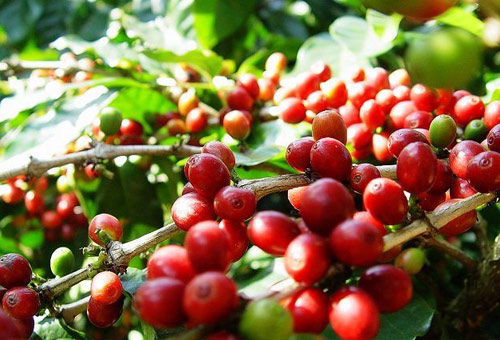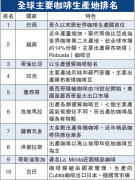The price of coffee beans the price of coffee beans affected by the drought in Brazil is likely to return this year.
Brazil is the world's largest coffee producer, with 17 of the 21 states producing coffee. The picture shows Brazilian coffee workers collecting coffee beans.
Dagong Finance and Economics, February 16 (Reporter Zheng Yunyang) since it was introduced into Europe through Italy, the smell of coffee has spread to every corner of the world. Production in Brazil, the world's largest coffee producer, has declined in recent years, and coffee prices rose 50% year-on-year in 2014. Traders predict that if supply and demand continue to be out of balance, coffee bean prices may rise by 40% to 50% this year, and coffee fans around the world may have to continue to endure expensive coffee.
Although commodity prices are weak, the price of coffee beans remains stable. Coffee was the best-performing commodity in 2014, outperforming crude oil, natural gas, copper and soybeans. The price of Arabica beans (Arabrica), commonly known as Arabica coffee, rose 50 per cent last year and was still up 5-8 per cent at the start of the year, and commodity traders are bullish on the prospect of coffee. In fact, in the commodity market, crude oil is the largest trading volume, followed by coffee beans.
The price has risen to more than two dollars per pound.
After the sharp rise in coffee prices in 2014, prices have remained stable so far this year because of supply and demand. Brazil, the world's largest coffee producer, has experienced its worst drought in more than a decade, resulting in a sharp drop in global coffee supplies.
Brazil supplies one-third of the world's coffee demand, but Brazil's coffee harvest in 2014 was the worst in three years. Coffee prices rose further, rising above $2 a pound, and large coffee chains such as Starbucks quickly followed suit to raise the price of coffee drinks.
The two major varieties of coffee, the most popular in the market is Arabica coffee beans, which are produced in Latin American countries, including Brazil and Colombia, and coffee futures on the New York ICE Exchange in the United States are traded on Arabica beans from 19 countries.
Robusta is the second largest variety of coffee in the world, accounting for about 20% of the world coffee production. It has a strong sour taste and is mainly grown in some tropical countries such as Indonesia, mostly for instant coffee.
Colombia is the third largest coffee producer in the world and the second largest Arabica bean producer in the world. Although it has accelerated production to meet global demand for coffee, Colombia's coffee production is only about one-fourth of that of Brazil. Even if production increases, it can only temporarily ease the shortage of coffee supply.
Coffee farmers in coffee-producing countries make money only if coffee beans sell for at least one dollar per pound. If the price of coffee beans falls below one dollar, the income of coffee-producing countries may be affected, and production needs to be adjusted to support coffee prices. The price of coffee is affected by harvest and supply and demand, while climate and coffee diseases are the main factors affecting the harvest.
The market is worried about insufficient rainfall in the planting area.
Brazil supplies the world's largest coffee production, with the annual harvest period from April to August, and investors worry that if rainfall in Brazil's coffee-growing areas continues to be low, coffee bean prices could return to a high of $2 a pound.
The price of Arabica coffee beans rose 3.2 per cent to $1.6455 a pound on Friday. Commodity investment managers are bullish on the coffee market in 2015 and expect coffee prices to rise by 40% to 50%. Coffee futures prices can easily rise to a high of $3 per pound, and coffee futures rose by more than $3 per pound in May 2011.
As coffee production falls short of demand, prices naturally rise, and coffee traders and consumers have to endure expensive coffee. Sales fell immediately after J.M.Smucker raised the price of its Folgers coffee brand.
Coffee roaster and trader Socafe said he was concerned about the Brazilian coffee harvest in May and June this year, fearing that coffee prices would rise further.

Important Notice :
前街咖啡 FrontStreet Coffee has moved to new addredd:
FrontStreet Coffee Address: 315,Donghua East Road,GuangZhou
Tel:020 38364473
- Prev

Is the SAECO coffee machine easy to use? what do you think of coffee oil thickness coffee extract
The thickness of SPRESSO grease is a very complicated problem, which is much more complicated than the color of grease. The thickness of the grease is essential for making a real cappuccino and the popular coffee flower, so the rich and long-lasting grease can be said to be an important sign of high-quality ESPRESSO.
- Next

Global ranking of major coffee producing areas Coffee mesh powder Coffee producing areas Europe and America Coffee text
Related
- Why are the coffee in some coffee shops not enough after being frozen? What should I make up for my American latte cappuccino coffee after being frozen?
- How much water does it take to steam coffee by hand? Why is the coffee brewing and steaming time 30 seconds? What is the purpose of steaming coffee?
- The suspected drink contains too much caffeine! Overlord Tea Lady responds urgently!
- Starbucks rejects antique paper coupons?! Netizen: Missed marketing opportunities!
- What ratio of water temperature and ground does the smart cup method use to press coffee? The difference between brewed coffee and filtered coffee?
- What is the standard process for the purpose of coffee cup testing? What is the difference between hand-brewed coffee and cup testing?
- How to use hand-brewed coffee paragon small golden balls? How does cold coffee lock in the aroma of coffee?
- Is American coffee black? What is the difference between American coffee and drip coffee?
- Unexpected! Well-known tea beverage brand Lele Tea will withdraw from the Zhengzhou market!
- Starbucks enters the fashion and beauty industry?! Netizen: Give me an ice American eye cream

